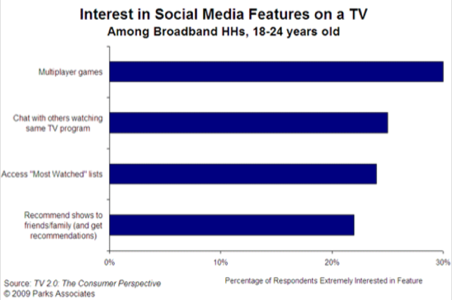Last March, we reported that over one-fourth of users ages 18-24 are interested in having more social media features integrated into their TVs. Yet, while a lot of interactions on social media sites center around TV shows, TVs are not exactly hubs for social media interactions, and those TV shows that integrate social networking into their programming often don’t do much more than read tweets aloud.

This post on Internet-based television is part of a sponsored content series by Intel smart TV.
Some cable companies, including Verizon’s FIOS, now allow users to see what others are tweeting about a show with the help of the set-top boxes. But this is still a one-way street where no real communication between the show and the viewer takes place, and users can’t really use the Twitter integration to discuss shows with their friends.

Making TV Social
Thanks to the advent of connected TVs, however, we are now getting to the point where a more interactive experience is possible. After all, these TVs, as well as the set-top boxes from vendors like Roku or Boxee are nothing more than small Internet-connected computers. With the right APIs and access to the current programming schedule, developers could easily create applications that allow viewers to discuss a show with their Facebook friends, for example. While these kinds of APIs are currently not widely available, IPTV and third-party set-top manufacturers could soon inspire developers to create more interactive TV experiences that integrate social networking and conversation features.
On the most basic level, these appliances can tell us what our friends are currently watching, but according to a 2009 study by Parks Associates, the social media feature most younger users are interested in is chatting with others who are watching the same TV program. While not directly connected to the TV right now, we have seen the launch of a number of social check-in apps centered around TV shows, but there is no reason why these apps that currently mostly run on smartphones couldn’t be integrated directly into the TV experience as well.
For pre-recorded shows, this could mean that users can interact with their friends as they are watching the same show at the same time, or see what their friends had to say about a given show if they were not watching simultaneously.
“The User Experience is Crucial”
There are some limitations to how much people want to type while watching a show, though, as well as how much screen real-estate they want to hand over to these features. Maybe just a limited set of emoticons (laugh, sad, angry, etc.) could be enough for most to make their opinion known without having to reach for a wireless keyboard. Steve Rubel, who closely follows these developments as the director of insights for Edelman Digital, told MIT’s Technology Review earlier this year that in implementing these features the “user experience is crucial, and the simplicity of it is crucial.”
All of this, of course, also applies to live shows, but there, a two-way communication between the viewers and the hosts is possible. While hosts can’t exactly respond to every tweet and comment live on the air, they can pick out representative comments and tweak the live program according to the aggregate opinion of the audience.
Beyond the TV
One thing most early pioneers of social and interactive TV did not consider, though, was the rise of smartphones and tablet computers that could handle the social functions instead of the TV. ABC, for example, currently uses Nielsen’s Media-Sync technology in order to offer social features in an iPad app for its new series MyGeneration. The app uses the iPad’s microphone to stay in sync with the show and pops up quizzes, displays trivia related to the show and allows viewers to connect with other fans in real time.
Photo by sonnyleon










